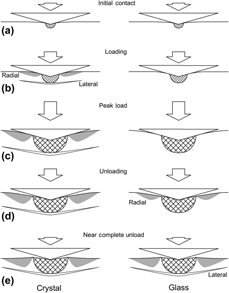Crossref Citations
This article has been cited by the following publications. This list is generated based on data provided by
Crossref.
Burch, Alexandra C.
Yeager, John D.
and
Bahr, David F.
2019.
Indentation fracture behavior of energetic and inert molecular crystals.
Journal of Materials Research,
Vol. 34,
Issue. 23,
p.
3954.
Cook, Robert F.
2020.
A critical evaluation of indentation crack lengths in air.
Journal of the American Ceramic Society,
Vol. 103,
Issue. 4,
p.
2278.
Varis, Tommi
Suhonen, Tomi
Laakso, Jarmo
Jokipii, Mika
and
Vuoristo, Petri
2020.
Evaluation of Residual Stresses and Their Influence on Cavitation Erosion Resistance of High Kinetic HVOF and HVAF-Sprayed WC-CoCr Coatings.
Journal of Thermal Spray Technology,
Vol. 29,
Issue. 6,
p.
1365.
Sajzew, Roman
Limbach, Rene
and
Wondraczek, Lothar
2020.
Deformation and Fracture of Silica Glass Fiber Under Sharp Wedge-Indentation.
Frontiers in Materials,
Vol. 7,
Issue. ,
Mirsalimov, Vagif M.
2021.
Elastic–plastic problem for a circular hole plate with regard to crack initiation in elastic zone.
Archive of Applied Mechanics,
Vol. 91,
Issue. 4,
p.
1329.
Fang, Xufei
Bishara, Hanna
Ding, Kuan
Tsybenko, Hanna
Porz, Lukas
Höfling, Marion
Bruder, Enrico
Li, Yingwei
Dehm, Gerhard
and
Durst, Karsten
2021.
Nanoindentation pop‐in in oxides at room temperature: Dislocation activation or crack formation?.
Journal of the American Ceramic Society,
Vol. 104,
Issue. 9,
p.
4728.
Hu, Jianhua
Xiang, Rui
Wen, Guanping
Ma, Shaowei
and
Pang, Le
2022.
Study on the Influence of Shear Indenter Parameters on the In Situ Shear Strength Test.
Minerals,
Vol. 12,
Issue. 5,
p.
618.
Li, Biao
Li, Peidong
Zhou, Runhua
Feng, Xi-Qiao
and
Zhou, Kun
2022.
Contact mechanics in tribological and contact damage-related problems: A review.
Tribology International,
Vol. 171,
Issue. ,
p.
107534.
Zhao, Siwei
Zhang, Jianwei
Li, Yuanxin
Liu, Haitao
Wang, Bingbing
and
Zhao, Minghao
2022.
An indentation method for determining the film thickness, Young’s modulus, and hardness of bilayer materials.
Journal of Physics D: Applied Physics,
Vol. 55,
Issue. 27,
p.
274002.
2023.
Particle Strengths.
p.
29.
2023.
Particle Strengths.
p.
369.
Li, Yan
Fang, Xufei
Tochigi, Eita
Oshima, Yu
Hoshino, Sena
Tanaka, Takazumi
Oguri, Hiroto
Ogata, Shigenobu
Ikuhara, Yuichi
Matsunaga, Katsuyuki
and
Nakamura, Atsutomo
2023.
Shedding new light on the dislocation-mediated plasticity in wurtzite ZnO single crystals by photoindentation.
Journal of Materials Science & Technology,
Vol. 156,
Issue. ,
p.
206.
Li, Yulong
Schreiber, Paul
Schneider, Johannes
and
Greiner, Christian
2023.
Tribological mechanisms of slurry abrasive wear.
Friction,
Vol. 11,
Issue. 6,
p.
1079.
Han, Guoqing
Tan, Mengting
Deng, Jiajie
Li, Yi
Mao, Xiaojian
and
Zhang, Xianfeng
2024.
Static indentation responses of AlON transparent ceramics.
Ceramics International,
Vol. 50,
Issue. 17,
p.
29306.
Zhao, Siwei
Li, Yuanxin
Zhang, Jianwei
Wang, Bingbing
Zhao, Minghao
and
Lu, Chunsheng
2024.
An Indentation Method for Determining the Elastic Modulus, Hardness and Film Thickness of a Tri-Layer Materials.
International Journal of Applied Mechanics,
Vol. 16,
Issue. 04,
Vakhshouri, Maryam
Najafzadehkhoee, Aliasghar
Talimian, Ali
Pernia, Cristina López
Poyato, Rosalía
Gallardo-López, Ángela
Gutiérrez-Mora, Felipe
Prnova, Anna
and
Galusek, Dušan
2024.
Al2O3/Y3Al5O12 (YAG)/ZrO2 composites by single-step powder synthesis and spark plasma sintering.
Journal of the European Ceramic Society,
Vol. 44,
Issue. 12,
p.
7180.
Rajendran, Sundarakannan
Palani, Geetha
Karthik Babu, NB
Veerasimman, Arumuga Prabu
Yang, Yo-Lun
and
Shanmugam, Vigneshwaran
2024.
Solid particle erosion in fibre composites: A review.
Journal of Reinforced Plastics and Composites,
Amini, Shahrouz
Zhu, Tingting
Razi, Hajar
Griesshaber, Erika
Werner, Peter
and
Fratzl, Peter
2024.
In operando 3D mapping of elastic deformation fields in crystalline solids.
Matter,
Vol. 7,
Issue. 7,
p.
2591.
Teles, Vinicius Carvalho
de Oliveira, Sonia Aparecida Goulart
and
da Silva, Washington Martins
2024.
Lateral cracks in soda-lime glass under the threshold load due to the interaction of indentations.
Journal of the Brazilian Society of Mechanical Sciences and Engineering,
Vol. 46,
Issue. 11,
2025.
Indentation Fracture.
p.
67.
